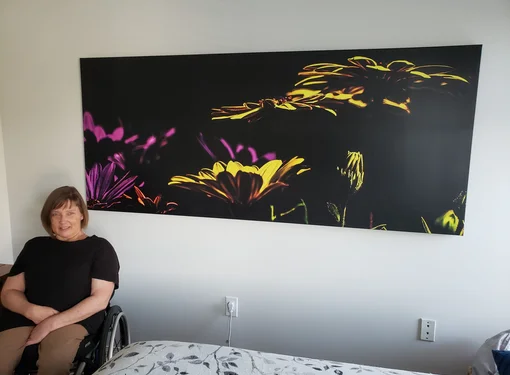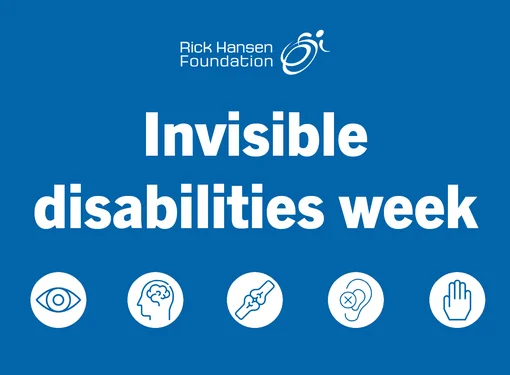Why Menopause Belongs in the Accessibility Conversation
Menopause is not a disability. So why is the Rick Hansen Foundation (RHF) writing about it?
It’s because symptoms can be debilitating and, due to a long-standing lack of awareness (which is finally changing), it can blindside many women between 40 and 50. Disability is defined by the effect of a condition, not the condition itself. We’re also highlighting menopause because October is World Menopause Month, a time to raise awareness, challenge stigma, and bring compassion into conversations that half the population will one day experience.
We’re also adding our voice to the menopause revolution underway. Actor Naomi Watts wrote a book about it. Oprah Winfrey hosted a primetime special. Women are reclaiming the narrative of their own biology and speaking openly about everything from hot flashes and brain fog to sleep disruption and lethargy. What was once considered taboo and quietly referred to as ‘The Change’, menopause is finally being discussed around boardroom tables, in clinics, among friends, and on public stages.
As it should. With just over half of Canada’s population being biologically female, that accounts for 20 million people. And, according to the Menopause Foundation of Canada, a not-for-profit organization that advocates for the support women need in their menopausal years, more than 10 million women are over the age of 40.

What is Menopause?
Menopause is a natural phase of life when a woman’s ovaries stop producing eggs, resulting in lower levels of estrogen and progesterone. It officially begins once a woman has gone 12 months without a period, typically around age 51. But the lead-up, referred to as perimenopause, can begin years earlier, with fluctuating hormones that affect everything from body temperature to cognition.
Every experience is unique. For some, symptoms are mild; for others, they’re life-altering. Night sweats, insomnia, anxiety, depression, joint pain, and even “frozen shoulder” can make daily life, including work, feel unmanageable. Too often, these symptoms – of which there are 30 in total, according to doctors - are brushed off as “just getting older.”
The Cost of Silence
For centuries, menopause has carried stigma and misunderstanding. Aristotle associated the end of menstruation with the end of usefulness. By the 19th century, male physicians labelled menopause “hysteria.” Even in the 1960s, a best-selling book described it as a disease to be “cured.”
That legacy of silence continues to shape women’s experiences today. Females are underrepresented in preclinical and clinical research; female-specific research representation accounts for less than 7% of funded grants over the last 15 years, according to the National Library of Medicine.
The result is that many women enter perimenopause unaware and unsupported.
This silence has economic costs, too. A 2023 report called Menopause and Work in Canada shows that unmanaged symptoms of menopause cost women $3.3B in lost income due to a reduction in hours and/or pay or leaving the workforce altogether. It also showed that menopause costs employers $237M annually in lost productivity.
The Menopause and Work in Canada report validates the steep toll menopause is taking at work:
- One-third (32%) of working women say their menopause symptoms negatively impacted their performance at work.
- One-quarter (24%) say they hid their symptoms at work due to stigma and the pervasive ageism that impacts women.
- Two-thirds (67%) would not feel comfortable speaking to their supervisor or to someone in HR (70%) about what they were experiencing
- Half (48%) would be too embarrassed to ask for help at work.
Nearly 80 percent of Canadian women aged 45–54 are in the labour force, the fastest-growing segment of working women, yet few workplaces have policies or accommodations in place.

Accessibility in Action
At RHF, we advocate for a broader understanding of accessibility, one that goes far beyond ramps. It’s about creating environments where everyone can thrive. The experience of menopause provides another meaningful lens for expanding our understanding of accessibility and inclusion.
Some of the accommodations suggested through the Menopause Foundation of Canada’s Workplace Playbook include flexible scheduling, remote-work options, and well-timed breaks to help women manage fatigue. Even small shifts in lighting, ventilation, and access to restrooms or hydration can create more inclusive spaces.
By designing workplaces and policies with menopause in mind, we remove invisible barriers that impact millions. When we recognize that accessibility also means physiological inclusivity, we move closer to a world that works for everyone.
The Science Is Evolving
For years, menopause hormone therapy (MHT) carried a shadow of fear after a 2002 Women’s Health Initiative study found that combined estrogen and progestin led to a small increase in breast cancer, heart disease, and stroke. However, later information suggested that it depends on the type of MRT, age, and timing. A 2017 statement from the Society of Obstetricians and Gynecologists of Canada clarified that, for many women, starting it at midlife can be safe and beneficial, sometimes even reducing the risk of Alzheimer’s. However, misinformation persists, leaving countless women to suffer unnecessarily.
Education and research are catching up, but more investment and conversation are needed.
Being a part of breaking the silence around menopause is an act of inclusion. It’s about ensuring women aren’t sidelined at the peak of their lives, that they’re supported through physical changes, and that workplaces value their experience, leadership, and resilience. Inclusion also means making space for every chapter of life, not just the ones society finds comfortable.







